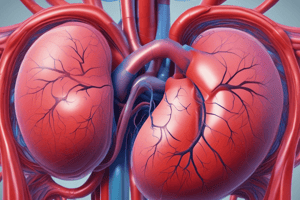Podcast
Questions and Answers
What is the primary function of arterioles in the circulatory system?
What is the primary function of arterioles in the circulatory system?
- Carry oxygenated blood back to the lungs
- Provide resistance to blood flow (correct)
- Supply blood to the heart
- Transport nutrients to cells
Dilation of arterioles decreases blood flow to downstream capillaries.
Dilation of arterioles decreases blood flow to downstream capillaries.
False (B)
What are the two major branches that the abdominal aorta splits into?
What are the two major branches that the abdominal aorta splits into?
Common iliac arteries
The section of the aorta between the ascending and descending aorta is called the ______.
The section of the aorta between the ascending and descending aorta is called the ______.
Which artery supplies blood to the kidneys?
Which artery supplies blood to the kidneys?
Match the following arteries with their respective supplies:
Match the following arteries with their respective supplies:
Hypertension is a condition characterized by persistently low blood pressure.
Hypertension is a condition characterized by persistently low blood pressure.
What medical condition is commonly referred to as high blood pressure?
What medical condition is commonly referred to as high blood pressure?
Which type of artery contains more elastic tissue and helps maintain a constant pressure gradient?
Which type of artery contains more elastic tissue and helps maintain a constant pressure gradient?
Pulmonary arteries carry oxygenated blood from the heart to the lungs.
Pulmonary arteries carry oxygenated blood from the heart to the lungs.
Name the primary function of arteries.
Name the primary function of arteries.
The smallest type of artery that distributes blood flow into capillary beds is called an __________.
The smallest type of artery that distributes blood flow into capillary beds is called an __________.
Match the following arteries with their definition:
Match the following arteries with their definition:
What type of arterial structure allows for contraction and expansion based on blood demand?
What type of arterial structure allows for contraction and expansion based on blood demand?
Arteries are responsible for supplying blood to the body's tissues and organs.
Arteries are responsible for supplying blood to the body's tissues and organs.
Identify one main branch of the aortic arch and its supply.
Identify one main branch of the aortic arch and its supply.
Flashcards are hidden until you start studying
Study Notes
Functions of Arteries
- Arteries transport blood away from the heart.
- Pulmonary arteries carry deoxygenated blood from the right ventricle to the lungs.
- Systemic arteries carry oxygenated blood from the left ventricle to the body.
Types of Arteries
- Elastic Arteries:
- Located nearest to the heart (aorta and pulmonary arteries).
- Contain more elastic tissue than muscular arteries.
- Maintain a relatively constant pressure gradient due to elastic tissue.
- Muscular Arteries:
- Medium-sized arteries.
- Branch from elastic arteries and lead to smaller arteries and arterioles.
- Contain more smooth muscle, allowing for vasoconstriction and vasodilation based on blood demand.
- Arterioles:
- Considered the primary resistance vessels.
- Distribute blood flow into capillary beds.
- Provide about 80% of the total resistance to blood flow.
- Constriction increases resistance, decreasing blood flow to capillaries and raising blood pressure.
- Dilation decreases resistance, increasing blood flow to capillaries and lowering blood pressure.
The Aorta
- The aorta is the main artery in the body.
- It carries oxygenated blood from the left ventricle.
- Parts of the aorta include:
- Ascending aorta
- Aortic arch
- Descending aorta (Thoracic aorta)
- Abdominal aorta
Aortic Arch
- Located between the ascending and descending aorta.
- Supplies the head, neck, and upper limbs.
- Main branches:
- Brachiocephalic trunk
- Right common carotid artery (internal and external)
- Right subclavian artery (supplies right vertebral artery)
- Left common carotid artery (internal and external)
- Left subclavian artery (supplies left vertebral artery)
- Brachiocephalic trunk
Abdominal Aorta
- Continuation of the thoracic aorta.
- Begins at the diaphragm and descends to the point where it splits into two common iliac arteries.
- Supplies oxygenated blood to all abdominal and pelvic organs and the legs.
- Main branches:
- Single (unpaired)
- Celiac trunk: Supplies the liver, stomach, spleen, superior duodenum, and superior pancreas.
- Superior mesenteric artery: Supplies the distal duodenum, jejunum, ileum, ascending colon, and part of the transverse colon.
- Inferior mesenteric artery: Supplies the large intestine from the end of the transverse colon to the rectum.
- Paired
- Suprarenal arteries: Supply the adrenal glands.
- Renal arteries: Supply the kidneys.
- Gonadal arteries: Male gonadal (testicular) artery and female gonadal (ovarian) artery.
- Single (unpaired)
Hypertension
- Also known as high blood pressure.
- Characterized by persistently raised pressure in blood vessels.
- Blood pressure is the force of blood pushing against the walls of arteries as it is pumped by the heart.
- Higher pressure means the heart has to work harder to pump blood.
- Hypertension is a serious condition that increases the risk of heart, brain, kidney, and other diseases.
Studying That Suits You
Use AI to generate personalized quizzes and flashcards to suit your learning preferences.



